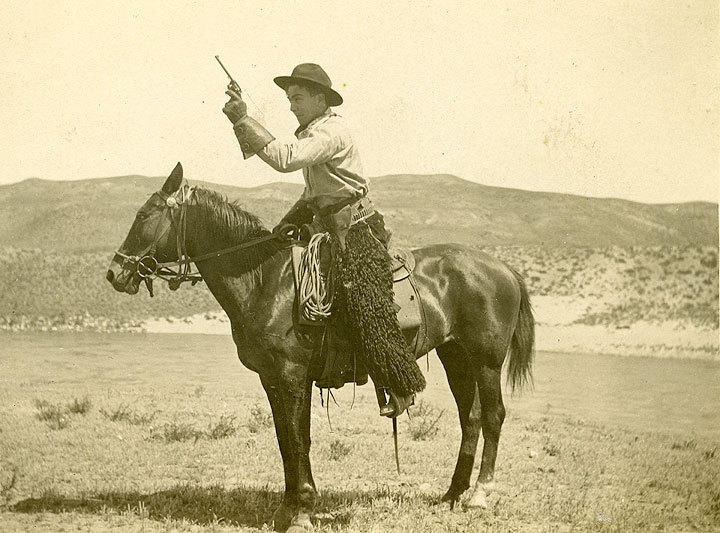The image of the American cowboy has taken on almost mythic status. From the dime novels of the 19th century to Buffalo Bill’s Wild West Show to Hollywood Westerns starring John Wayne, the cowboy has become a symbol of rugged individualism, an American original. Writers have long questioned the romanticizing of the cowboy and the old West — its violence and misogyny, for example. And now some historians are focusing on little-explored aspects of the politics and history of the American West that raise new questions about how the West was won.
At the recent Crosscut Festival, I had the honor of interviewing historian Heather Cox Richardson, a Boston College professor, about her book, How the South Won the Civil War: Oligarchy, Democracy and the Continuing Fight for the Soul of America. In recent years, Richardson’s daily newsletter has offered historical context for the drama she sees playing out in the country — in her view, a long struggle between the forces of oligarchy and democracy.
The most epic clash in this centuries-long struggle was the Civil War. Then, reformers in the form of abolitionists and the new Republican Party opposed the plans of Southern enslavers to extend the structures of white supremacy and racial inequality into the Western territories. In her book, Richardson argues that although the South was defeated militarily and slavery abolished, the Confederacy and its supporters won the larger argument about building America based on institutionalized inequality.
It’s not that Southern whites invented inequality. From the beginning, the American experiment has harbored what Richardson calls a paradox. While the nation has long proclaimed that all men are created equal, it has simultaneously ensured that this promise would never be realized. Women, people of color, immigrants and American Indians were left out of the equality equation. Today, with mass incarceration, voter suppression, limits on citizenship, immigration and asylum restrictions, economic inequality and perpetually unmet treaty obligations, we still live with systemic inequalities as surely as did many of our founders who touted freedom for all while preserving slavery for many.
The Civil War and Reconstruction were efforts to expand equality. The South resisted and later rewrote that history to reflect the idea that it was Southern whites who were oppressed (see Birth of a Nation). Many fled to the wide-open spaces of the Western territories to start anew and found a fertile environment for escaping — or the illusion of escaping — federal government control. For many, a libertarian ethic kicked in: Freedom is doing what you want when you want. They embodied the politics of low regulation, of expecting everyone to fend for themselves. The image of the cowboy was also whitened. Richardson says probably a third of actual cowboys were people of color, mostly Mexican and Black. That let elites off the hook to grow, accumulate and plunder as they wished, while the white “cowboy” could live free, unrestricted by real and social fences.
As the settlers moved west, they brought with them attitudes about “states' rights” and postwar anxieties about the future of so-called “free white labor” that post-Reconstruction would have to now compete with Black people for jobs. Their racial entitlement was now eliminated in law. They arrived to a racially complex region on the frontier. Native peoples were being exterminated, enslaved and displace by settlement, conflict and exploitive industries. Large populations of Mexicans were being removed from their lands in California and the Southwest. The West Coast was brimming with newly arrived Chinese laborers, who were being exploited and abused by the railroad builders and mine owners. This combined with a white population determined to keep themselves at the top of the opportunity and power pyramid.
The myth of the cowboy — the individualist — was a kind of cover for the attitudes that favored large employers, including mining, railroad, financial and ranching interests. The bosses discouraged workers from unionizing or acting collectively. To the oligarchs East and West, North and South, the idea of the unrestrained individualism of the cowboy, devoid of responsibility for others, suited a divide-and-conquer strategy very well.
That spirit was based on the lack of independence and equality for others. Women were wives and stay-at-home “civilizers” who were unpaid labor (see Little House on the Prairie); the full force of the U.S. Army — led by former Union officers — turned away from helping Blacks in the South during Reconstruction to exterminating or corralling Indigenous peoples; and vigilantes in California, Oregon and Nevada, modeled on the Ku Klux Klan and sometimes adopting its name, murdered, lynched and tormented Asian residents. Nonwhites of all kinds were banned, herded to or kept at the margins.
Richardson writes: “The mythology of the self-made ‘new man,’ the cowboy, depended on the racial and gender hierarchies of the West. … [W]hile Republicans in the East had fought the Civil War to banish the idea that a few wealthy white men should rule society, Democrats in the West after the war were fighting for precisely that principle.”

Richardson’s compelling narrative helps make sense of the current moment in American politics, in particular the Jan. 6 standoff between an elected government and the insurrectionists waving the Confederate flag. It’s an event, she says, is unprecedented and took even her by surprise. Never before had the Confederate battle flag reached the Capitol, not even during the Civil War’s worst days.
Richardson's narrative also helps explain why the South and the inland West today vote almost exclusively for less government, less equality, more resource extraction and lower taxes. Ronald Reagan and Barry Goldwater, in their cowboy hats, became icons of Western-style Southern politics. Donald Trump’s base of support comes from the same territory, though his is more nakedly anti-democratic.
The plan to Southernize the West, however, was not mere outflow from Reconstruction, as shown by an important new book, West of Slavery: The Southern Dream of a Transcontinental Empire, by Kevin Waite, an assistant professor of 19th century history at Durham University in England. Waite demonstrates that, from Thomas Jefferson on, the South had big plans for the West. Jefferson sent Lewis and Clark and hoped to flood the frontier with white agrarian Democrats. The plantation owners wanted a port in California with access to Asia, opening new markets for cotton and creating the potential for a global empire driven by the South's slavery economy. Officials in Utah and New Mexico wrote provisions to permit enslaved workers in their territories. The prewar and Reconstruction-era politics of the West was dominated by Democrats and their patronage system and looked to take land and expand slavery westward.
Waite writes about the pro-slavery ambitions of a Westerner with North Carolina roots, a man named Thomas Jefferson Green. He wanted to build the first transcontinental railroad across the Southwest — what he called the “great slavery road” — that would help ensure the West was part of the expansion of slavery throughout the hemisphere.
In other words, the very structure of the West was partly built on the South's ambitions to create like-minded states — or, if necessary, an independent nation by secession. In the 1850s, some West Coast politicians considered plans for — if necessary — a secession of the Western states to create a new independent country tolerant of slavery. This idea, the so-called Pacific Republic, resurfaced during the Civil War, pushed by Southern sympathizers to aid the Confederacy in gaining a seaport and access to California’s gold and riches. The racial exclusion of both the homestead and territorial laws, including Oregon’s banning of people of color; the elimination of the right of nonwhites to testify in court; and the settlers' tolerance of chattel slavery are all part of the region’s foundations.
Waite's enlightening book provides details of the Southern strategy to “own” the West. He focuses on California and the Southwest. But our Northwest corner was not innocent. In early 1858, the Democrat-dominated Washington Territorial Assembly passed a resolution backing the Supreme Court’s dreadful Dred Scott decision, which lifted the ban on slavery in the Western territories and declared that Black Americans could never be citizens. The resolution also voiced support for the Kansas-Nebraska Act, legislation that set the stage for the Civil War by opening competition in Western territories over slavery, which had been previously disallowed by the Missouri Compromise. At that point the Washington Territory’s right to decide slavery for itself was more important than the rights of Black Americans.
We as a society have paid less attention to these bedrock issues than they deserve. Books like Richardson’s and Waite’s begin to fill in an important picture of the very foundations of our region, one that goes beyond cowboy fantasies. And while Southern ideas and plans may have been extremely consequential, the system that has enabled them — that American paradox — has given rise to a constant battle, as Richardson puts it, for the American soul. What is American democracy all about? Is it about spreading equality? Or is its future in the hands of oligarchs? That latter view was articulated by Peter Thiel, tech entrepreneur, self-described libertarian and Donald Trump supporter, who in 2009 said, “I no longer believe that freedom and democracy are compatible.” He is not alone in that belief.
There is a lot that is good about the cowboy image: hard work, a sense of self-reliance. Those steeped in the imagery of the West won’t easily be dislodged from romantic notions or deterred from wearing Stetsons and listening to great country music. But it’s the sense that cowboys alone embody American values that is a problem, that the settling of the frontier was the apotheosis of the American Way. It leads to a history where exclusion is essentially celebrated, often unconsciously, as the only way to greatness.
The true story is more complex and often troubling. And it puts the present into a very relevant context. We have been trying to have it both ways for a very long time — a democracy that sometimes attempts inclusion and expands equality imperfectly, such as during Reconstruction, the Progressive movement of Theodore Roosevelt and Franklin Roosevelt’s New Deal, and one that still relies on and attempts to increase systemic inequalities that erode democracy.
At some point the paradox won’t stand.



